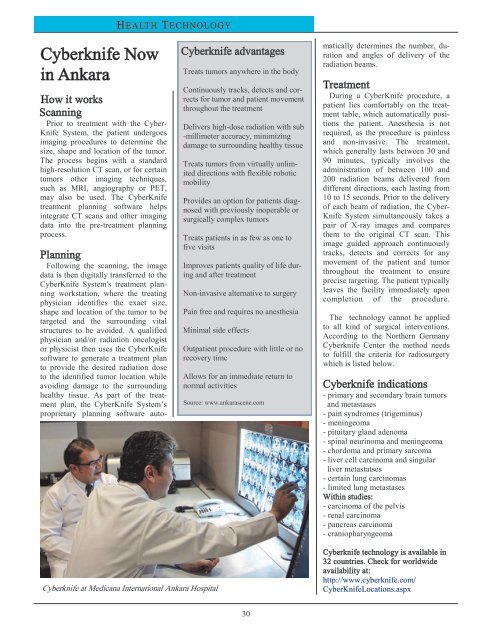Thepatients_prot
Create successful ePaper yourself
Turn your PDF publications into a flip-book with our unique Google optimized e-Paper software.
HEALTH TECHNOLOGY<br />
Cyberknife Now<br />
in Ankara<br />
How it works<br />
Scanning<br />
Prior to treatment with the Cyber-<br />
Knife System, the patient undergoes<br />
imaging procedures to determine the<br />
size, shape and location of the tumor.<br />
The process begins with a standard<br />
high-resolution CT scan, or for certain<br />
tumors other imaging techniques,<br />
such as MRI, angiography or PET,<br />
may also be used. The CyberKnife<br />
treatment planning software helps<br />
integrate CT scans and other imaging<br />
data into the pre-treatment planning<br />
process.<br />
Cyberknife advantages<br />
Treats tumors anywhere in the body<br />
Continuously tracks, detects and corrects<br />
for tumor and patient movement<br />
throughout the treatment<br />
Delivers high-dose radiation with sub<br />
-millimeter accuracy, minimizing<br />
damage to surrounding healthy tissue<br />
Treats tumors from virtually unlimited<br />
directions with flexible robotic<br />
mobility<br />
Provides an option for patients diagnosed<br />
with previously inoperable or<br />
surgically complex tumors<br />
Treats patients in as few as one to<br />
five visits<br />
Improves patients quality of life during<br />
and after treatment<br />
Non-invasive alternative to surgery<br />
Pain free and requires no anesthesia<br />
Minimal side effects<br />
Outpatient procedure with little or no<br />
recovery time<br />
Allows for an immediate return to<br />
normal activities<br />
Source: www.ankarascene.com<br />
Planning<br />
Following the scanning, the image<br />
data is then digitally transferred to the<br />
CyberKnife System's treatment planning<br />
workstation, where the treating<br />
physician identifies the exact size,<br />
shape and location of the tumor to be<br />
targeted and the surrounding vital<br />
structures to be avoided. A qualified<br />
physician and/or radiation oncologist<br />
or physicist then uses the CyberKnife<br />
software to generate a treatment plan<br />
to provide the desired radiation dose<br />
to the identified tumor location while<br />
avoiding damage to the surrounding<br />
healthy tissue. As part of the treatment<br />
plan, the CyberKnife System’s<br />
proprietary planning software automatically<br />
determines the number, duration<br />
and angles of delivery of the<br />
radiation beams.<br />
Treatment<br />
During a CyberKnife procedure, a<br />
patient lies comfortably on the treatment<br />
table, which automatically positions<br />
the patient. Anesthesia is not<br />
required, as the procedure is painless<br />
and non-invasive. The treatment,<br />
which generally lasts between 30 and<br />
90 minutes, typically involves the<br />
administration of between 100 and<br />
200 radiation beams delivered from<br />
different directions, each lasting from<br />
10 to 15 seconds. Prior to the delivery<br />
of each beam of radiation, the Cyber-<br />
Knife System simultaneously takes a<br />
pair of X-ray images and compares<br />
them to the original CT scan. This<br />
image guided approach continuously<br />
tracks, detects and corrects for any<br />
movement of the patient and tumor<br />
throughout the treatment to ensure<br />
precise targeting. The patient typically<br />
leaves the facility immediately upon<br />
completion of the procedure.<br />
The technology cannot be applied<br />
to all kind of surgical interventions.<br />
According to the Northern Germany<br />
Cyberknife Center the method needs<br />
to fulfill the criteria for radiosurgery<br />
which is listed below.<br />
Cyberknife indications<br />
- primary and secondary brain tumors<br />
and metastases<br />
- pain syndromes (trigeminus)<br />
- meningeoma<br />
- pituitary gland adenoma<br />
- spinal neurinoma and meningeoma<br />
- chordoma and primary sarcoma<br />
- liver cell carcinoma and singular<br />
liver metastatses<br />
- certain lung carcinomas<br />
- limited lung metastases<br />
Within studies:<br />
- carcinoma of the pelvis<br />
- renal carcinoma<br />
- pancreas carcinoma<br />
- craniopharyngeoma<br />
Cyberknife at Medicana International Ankara Hospital<br />
Cyberknife technology is available in<br />
32 countries. Check for worldwide<br />
availability at:<br />
http://www.cyberknife.com/<br />
CyberKnifeLocations.aspx<br />
30


